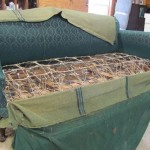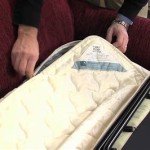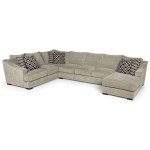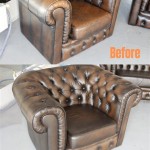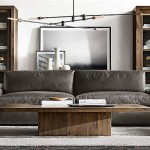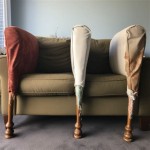How To Attach Sofa Feet to a Bed Frame
Attaching sofa feet to a bed frame is a common modification undertaken to elevate the bed, improve aesthetics, or allow for under-bed storage. This process, while seemingly simple, requires careful planning, appropriate materials, and precise execution to ensure stability and prevent damage to both the bed frame and the floor. The following article details the steps involved in securely attaching sofa feet to a bed frame, providing guidance on material selection, installation techniques, and potential challenges.
The need to attach sofa feet to a bed frame typically arises from a few key motivations. First, increasing the height of the bed can be beneficial for individuals with mobility issues, making it easier to get in and out of bed. Second, the additional space created underneath the bed can serve as valuable storage, particularly in smaller living spaces. Third, replacing existing bed legs with aesthetically pleasing sofa feet can drastically improve the overall appearance of the bedroom. Regardless of the motivation, the attachment process must be performed with care to avoid compromising the structural integrity of the bed.
Key Considerations Before Starting
Before commencing the attachment process, several factors must be thoroughly assessed. These include the type of bed frame, the weight capacity of the sofa feet, and the appropriate method of attachment.
The type of bed frame significantly influences the choice of attachment method. Bed frames constructed from solid wood typically offer a more robust foundation for attaching sofa feet compared to those made from metal or composite materials. Metal frames may require welding or specialized brackets, while composite materials might necessitate reinforcement to prevent cracking or splitting. Understanding the composition of the bed frame is crucial for selecting the appropriate hardware and techniques.
The weight capacity of the sofa feet is another critical consideration. The combined weight of the mattress, bedding, and occupants must not exceed the load-bearing capacity of the feet. Exceeding this limit can lead to instability, damage to the feet, or even collapse of the bed. Consult the manufacturer's specifications for the sofa feet to determine their maximum weight capacity. If the existing feet are being replaced, it is essential to ensure that the new feet offer at least the same level of support.
Determining the appropriate method of attachment is largely dependent on the materials of both the bed frame and the sofa feet. Common attachment methods include screwing, bolting, and using adhesive. Screwing is generally suitable for wooden frames, while bolting may be preferred for metal frames. Adhesive, while convenient, is typically not recommended as the sole means of attachment due to its limited strength and potential for failure over time. A combination of methods, such as screwing and applying adhesive, can provide a more secure and durable connection.
Materials and Tools Required
Successfully attaching sofa feet to a bed frame requires the right tools and materials. The following list provides a comprehensive overview of the items typically needed:
- Sofa feet: Select feet that are appropriately sized, designed, and rated for the intended weight. Consider the aesthetic design of the feet to ensure they complement the existing bedroom decor.
- Screws or bolts: Choose screws or bolts that are compatible with the materials of both the bed frame and the sofa feet. The length of the screws or bolts should be sufficient to provide a secure hold, but not so long that they protrude through the other side of the frame.
- Drill: A power drill is essential for creating pilot holes and driving screws or bolts. Ensure that the drill is equipped with the appropriate drill bits for the materials being used.
- Drill bits: A selection of drill bits in various sizes is necessary for creating pilot holes. Start with a small drill bit and gradually increase the size until the desired diameter is achieved.
- Screwdriver or wrench: A screwdriver or wrench is needed to tighten the screws or bolts. Select a screwdriver or wrench that is compatible with the head of the screws or bolts being used.
- Measuring tape: A measuring tape is used to accurately determine the placement of the sofa feet. Precise measurements are crucial for ensuring stability and a uniform appearance.
- Pencil or marker: A pencil or marker is used to mark the locations for the pilot holes. Use a sharp pencil or fine-tip marker for accurate markings.
- Level: A level is used to ensure that the sofa feet are installed at the same height. This is essential for maintaining the stability of the bed.
- Sandpaper (optional): Sandpaper may be needed to smooth any rough edges on the bed frame or sofa feet.
- Wood glue (optional): Wood glue can be used in conjunction with screws to provide a stronger bond between the sofa feet and a wooden bed frame.
- Clamps (optional): Clamps can be used to hold the sofa feet in place while the adhesive dries or the screws are tightened.
Step-by-Step Installation Guide
The following steps provide a detailed guide on how to attach sofa feet to a bed frame:
Step 1: Preparation. Begin by clearing the area around the bed frame. Remove the mattress, bedding, and any other items that may obstruct the attachment process. Inspect the bed frame for any existing damage or weaknesses. Repair any damage before proceeding.
Step 2: Marking the Locations. Use a measuring tape and pencil to mark the locations for the sofa feet. Ensure that the feet are evenly spaced and positioned in a way that provides maximum support. A common practice is to position the feet at the corners of the bed frame, as well as potentially adding additional feet along the center supports for larger beds. The dimensions of your sofa feet will dictate exactly where they should be positioned to have optimal contact and support. Double-check all measurements before proceeding.
Step 3: Drilling Pilot Holes. Using a drill and the appropriate-sized drill bit, create pilot holes at the marked locations. The pilot holes should be slightly smaller than the diameter of the screws or bolts being used. Drilling pilot holes prevents the wood from splitting and makes it easier to drive the screws or bolts. For metal frames, a metal-specific drill bit is mandatory, and be prepared for a longer drilling time.
Step 4: Attaching the Sofa Feet. Align the sofa feet with the pilot holes. If using screws, drive the screws into the pilot holes using a screwdriver. If using bolts, insert the bolts through the holes in the sofa feet and tighten them with a wrench. If using wood glue, apply a small amount of glue to the contact surface of the sofa feet before attaching them to the bed frame. Be sure to wipe away any excess glue to prevent sticking.
Step 5: Securing the Feet. Once the sofa feet are attached, double-check that they are securely fastened. Ensure that the screws or bolts are tightened to the appropriate torque. Over-tightening can damage the bed frame or the sofa feet. If using wood glue, allow the glue to dry completely before proceeding to the next step.
Step 6: Leveling the Bed. Use a level to ensure that the sofa feet are installed at the same height. If necessary, adjust the height of individual feet by adding shims or washers. Achieving a level bed is critical for comfort and stability.
Step 7: Testing the Stability. Once the sofa feet are securely attached and the bed is level, test the stability of the bed frame. Apply pressure to different areas of the bed to ensure that it does not wobble or creak. If any instability is detected, re-tighten the screws or bolts and make any necessary adjustments.
Step 8: Final Inspection. Perform a final inspection of the bed frame and sofa feet. Ensure that all screws or bolts are securely tightened and that there are no loose connections. Replace the mattress and bedding.
Troubleshooting Common Issues
Despite careful planning and execution, certain issues may arise during the attachment process. Understanding common problems and their solutions can help ensure a successful outcome.
Problem 1: Stripped Screws. Stripped screws occur when the screwdriver bit loses its grip on the screw head, often due to excessive force or using the wrong size screwdriver. To resolve this issue, try using a rubber band or steel wool between the screwdriver bit and the screw head to improve grip. If the screw is severely stripped, it may be necessary to extract it using a screw extractor tool and replace it with a new screw. Pre-drilling holes that are just large enough can mitigate this risk.
Problem 2: Splitting Wood. Splitting wood can occur when driving screws into a wooden bed frame, particularly if the wood is dry or brittle. To prevent this, always drill pilot holes before driving screws. If the wood does split, apply wood glue to the split area and clamp it together until the glue dries. Consider using larger diameter screws or bolts to provide additional strength.
Problem 3: Unstable Feet. Unstable feet can result from uneven surfaces, inadequate weight capacity, or loose connections. To address this, ensure that the feet are installed on a level surface. If the surface is uneven, use shims to level the feet. Verify that the feet are rated for the weight of the bed, mattress, and occupants. Tighten all screws or bolts to ensure a secure connection. Consider adding additional feet for enhanced support, especially for larger beds.
Problem 4: Misaligned Feet. Misaligned feet can compromise the aesthetic appearance and stability of the bed. Accurate measurements and careful marking are essential to prevent misalignment. If the feet are misaligned, loosen the screws or bolts and reposition the feet accordingly. Use a level to ensure that the feet are aligned properly. Recalculate measurements as necessary.
By carefully considering these factors and following the outlined steps, individuals can successfully attach sofa feet to a bed frame, enhancing both the functionality and aesthetic appeal of their sleeping space.

How To Attach Sofa Legs A Step By Living Spaces

How To Install Couch Legs

Miuline 4 Pcs Wooden Furniture Legs With Mounting Plate And S For Sofa Bed Cabinet Chai Right Angle 7 9in

Find Install Feet On Sofa

Buzifu 4pcs Sofa Legs Plastic Couch Feet Universal Chair Bed Black Tapered Furniture Replacement With Leg Mounting Plates S

Kivik Couches Savannah By Season

Watch How Adding Legs Transforms Your Sectional A Genius

Tcwhniev 4 Set Wooden Furniture Legs Sofa Replacement 6 15 20cm Solid Wood Table Square Feet With S For Couch Chair

How To Build A Platform Bed With Legs For 50 Joyful Derivatives

Kivik Couches Savannah By Season


